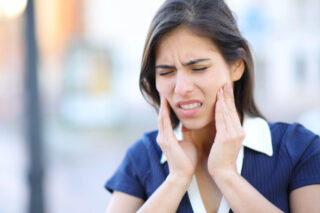
Sleep & TMJ Therapy
2841 Hartland Road
Suite #301
Falls Church, VA 22043
(703) 821-1103

More Dental Health Articles
TMJ Pain: What is the Cause

Living with TMJ (temporomandibular joint) pain can be challenging but understanding its causes and seeking professional care are key steps toward finding relief. The pain is real and affects everything surrounding jaw muscles to other parts of the body. Whether your discomfort stems from difficulty with everyday activities like eating or speaking, or other long-term impacts on overall health like migraines or hearing difficulties, the underlying factors need to be addressed and identified early. This can prevent long-term complications and improve your quality of life.
TMJ disorder’s (TMD) most common symptoms include bruxism (chronic teeth grinding and clenching), jaw pain, clicking or popping sounds, limited jaw movement, misaligned bite (missing teeth or abnormalities), headaches, earaches, connective tissue disorders (EDS, arthritis, or Lupus), and even neck and back pain. It is important to figure out what is causing these symptoms as one type of appliance or therapy may not be the correct path to solve the problem. Typically, the most common symptom is popping and clicking that is heard. This means the disc that sits on top of the condyle is slipping off when the jaw opens and pops back into place when the jaw closes. The second most common is bruxism. This is the group of muscles surrounding your jaw that function in speaking, grinding, and eating. The muscle tension can steam from your body naturally trying to get the disc back in place. The ear symptoms (pain, congestion, or ringing) generally are caused by the jaw being misaligned and the disc pushing against the ear canal or the jaw joint itself. The key to successful treatment is to know the cause first. Every patient’s situation is unique and involves careful evaluation and discussion.
Achieving a proper diagnosis and an effective treatment plan will involve a number of diagnosis methods. The combination of techniques to identify the root cause of TMD include:
Medical / Dental History and Symptom Review: The history of the patient provides possible understanding of any conditions causing the joint or bite problems. Understanding the onset, frequency, and severity of symptoms helps narrow down potential causes.
Physical Examination: The provider will evaluate tenderness throughout the muscles (head, neck and shoulders), and alignment, as well as listening for any sounds.
Imaging Needs: CBCT X-Rays are used to see the bone (head and neck) showing any possible causes. The MRI is used to see the soft tissue. How the disc behaves in the open and closed positions. Knowing the structure of the joints and surrounding tissues is critical with treatment.
Bite Analysis: Alignment and occlusion (how your teeth meet when biting) are evaluated to determine if a misaligned bite is contributing to the issue.
Don’t let TMJ pain hold you back from enjoying life’s simplest pleasures. TMD is complex but it is treatable most of the time without surgery. Reach out to your dentist to get a referral to a specialist. Your journey to wellness begins here.
Other Articles You May Find of Interest...
- Smart Strategies for Las Vegas Wisdom Tooth Extraction Professionals Recommend
- Beyond Calcium: The Complete Vitamin Blueprint for Stronger Teeth After 50
- The Best Mouthwash for Healthy Gums: What to Look For
- Effective Gingivitis Self-Care: Recognizing Signs and Understanding Treatment Options
- Your Complete Guide to Achieving and Maintaining Optimal Oral Health
- Full Mouth Rehabilitation: Fix All Teeth and Smile Again
- Sores on Roof of Mouth: Causes and Relief for Pain While Eating














